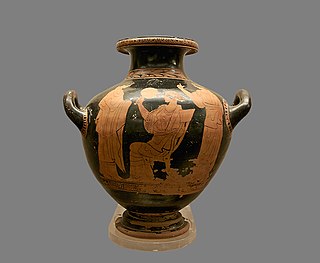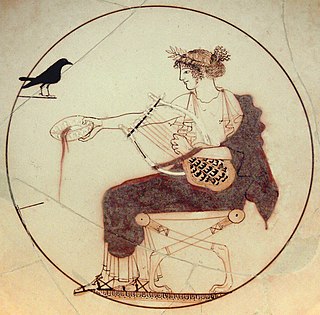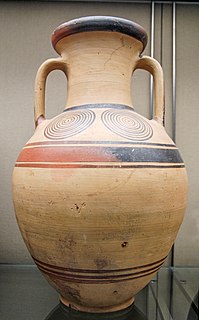
Sardis or Sardes was an ancient city at the location of modern Sart, near Salihli, in Turkey's Manisa Province. Sardis was the capital of the ancient kingdom of Lydia, an important city of the Persian Empire, the seat of a Seleucid satrap, the seat of a proconsul under the Roman Empire, and the metropolis of the province Lydia in later Roman and Byzantine times. It is mentioned in the New Testament. Its importance was due first to its military strength, secondly to it being situated on an important highway leading from the interior to the Aegean coast, and thirdly to its commanding the wide and fertile plain of the Hermus.

In the pottery of ancient Greece, a kylix is the most common type of wine-drinking cup. It has a broad, relatively shallow, body raised on a stem from a foot and usually two horizontal handles disposed symmetrically. The main alternative wine-cup shape was the kantharos, with a narrower and deeper cup and high vertical handles.

Ancient Greek pottery, due to its relative durability, comprises a large part of the archaeological record of ancient Greece, and since there is so much of it, it has exerted a disproportionately large influence on our understanding of Greek society. The shards of pots discarded or buried in the 1st millennium BC are still the best guide available to understand the customary life and mind of the ancient Greeks. There were several vessels produced locally for everyday and kitchen use, yet finer pottery from regions such as Attica was imported by other civilizations throughout the Mediterranean, such as the Etruscans in Italy. There were a multitude of specific regional varieties, such as the South Italian ancient Greek pottery.

Black-figure pottery painting, also known as the black-figure style or black-figure ceramic, is one of the styles of painting on antique Greek vases. It was especially common between the 7th and 5th centuries BCE, although there are specimens dating as late as the 2nd century BCE. Stylistically it can be distinguished from the preceding orientalizing period and the subsequent red-figure pottery style.

Exekias was an ancient Greek vase painter and potter who was active in Athens between roughly 545 BC and 530 BC. Exekias worked mainly in the black-figure technique, which involved the painting of scenes using a clay slip that fired to black, with details created through incision. Exekias is regarded by art historians as an artistic visionary whose masterful use of incision and psychologically sensitive compositions mark him as one of the greatest of all Attic vase painters. The Andokides painter and the Lysippides Painter are thought to have been students of Exekias.

Red-figure vase painting is one of the most important styles of figural Greek vase painting.

A krater or crater was a large vase in Ancient Greece, used for the dilution of wine with water.

The hydria is a form of Greek pottery from between the late Geometric period and the Hellenistic period. The etymology of the word hydria was first noted when it was stamped on a hydria itself, its direct translation meaning ‘jug’.

A lekythos is a type of ancient Greek vessel used for storing oil, especially olive oil. It has a narrow body and one handle attached to the neck of the vessel, and is thus a narrow type of jug, with no pouring lip; the oinochoe is more like a modern jug. In the "shoulder" and "cylindrical" types which became the most common, especially the latter, the sides of the body are usually vertical by the shoulder, and there is then a sharp change of direction as the neck curves in; the base and lip are normally prominent and flared. However, there are a number of varieties, and the word seems to have been used even more widely in ancient times than by modern archeologists. They are normally in pottery, but there are also carved stone examples.

White-ground technique is a style of white ancient Greek pottery and the painting in which figures appear on a white background. It developed in the region of Attica, dated to about 500 BC. It was especially associated with vases made for ritual and funerary use, if only because the painted surface was more fragile than in the other main techniques of black-figure and red-figure vase painting. Nevertheless, a wide range of subjects are depicted.
Geometric art is a phase of Greek art, characterized largely by geometric motifs in vase painting, that flourished towards the end of the Greek Dark Ages, c. 900–700 BC. Its center was in Athens, and from there the style spread among the trading cities of the Aegean. The Greek Dark Ages lasted from c. 1100 to 750 BC and include two periods, the Protogeometric period and the Geometric period, in reference to the characteristic pottery style. The vases had various uses or purposes within Greek society, including, but not limited to, funerary vases and symposium vases.

The Protogeometric style is a style of Ancient Greek pottery led by Athens produced between roughly 1030 and 900 BCE, in the first period of the Greek Dark Ages. After the collapse of the Mycenaean-Minoan Palace culture and the ensuing Greek Dark Ages, the Protogeometric style emerged around the mid 11th century BCE as the first expression of a reviving civilization. Following on from the development of a faster potter's wheel, vases of this period are markedly more technically accomplished than earlier Dark Age examples. The decoration of these pots is restricted to purely abstract elements and very often includes broad horizontal bands about the neck and belly and concentric circles applied with compass and multiple brush. Many other simple motifs can be found, but unlike many pieces in the following Geometric style, typically much of the surface is left plain.

The pottery of ancient Greece has a long history and the form of Greek vase shapes has had a continuous evolution from Minoan pottery down to the Hellenistic period. As Gisela Richter puts it, the forms of these vases find their "happiest expression" in the 5th and 6th centuries BC, yet it has been possible to date vases thanks to the variation in a form’s shape over time, a fact particularly useful when dating unpainted or plain black-gloss ware.

Bucchero is a class of ceramics produced in central Italy by the region's pre-Roman Etruscan population. This Italian word is derived from the Latin poculum, a drinking-vessel, perhaps through the Spanish búcaro, or the Portuguese púcaro.

A jia is a ritual vessel type found in both pottery and bronze forms; it was used to hold libations of wine for the veneration of ancestors. It was made either with four legs or in the form of a tripod and included two pillar-like protrusions on the rim that were possibly used to suspend the vessel over heat. The earliest evidence of the Jia vessel type appears during the Neolithic Period. It was a prominent form during the Shang and early Western Zhou dynasties, but had disappeared by the mid-Western Zhou.

The C Painter was one of the most important Attic black-figure vase painters. His works date to circa 575–550 BC. His conventional name was allocated by the archaeologist John Beazley. The C stands for "Corinthianising", a reference to the strong influence of Corinthian vase painting on the artist. He was successor to the Comast Group and used the relatively old-fashioned range of vessel shapes preferred by that group, including lekanis, tripod kothon and skyphos. In contrast, he also painted quite innovative lekythoi with pronounced shoulders, although the more conservative Deinaeira type was still in use by some workshops at his time. The C Painter was the first Attic vase painter to paint cups without an offset lip, the Merrythought cup.

A Siana cup is a type of Attic cup decorated in the black-figure technique. They are named after one of their find locations, the Necropolis of the ancient city of Siana on Rhodes. During the second quarter of the 6th century BC, Siana cups were the predominant cup shape in Athens. The shape remained popular later and was still being produced in large quantities during the era of the Little-master cups.

The Phrynos Painter was an Attic black-figure vase painter, active in Athens between c. 560 and 545 BC. He was allocated the conventional name "Phrynos Painter" after the potter Phrynos, as he had painted three cups signed by the latter:

Larnaca District Museum is a museum in Larnaca, Cyprus that has displays that show the "historical development of the city of Kition and the District of Larnaka in general." It was inaugurated in 1969. and was formerly named Larnaca District Archaeological Museum. It is controlled by the Department of Antiquities.

The Nolan amphora is a variant style of the amphora jar, a common artifact of Greek and Roman pottery. Nolan amphorae are characterized by a neck that is longer and narrower than in traditional neck amphorae, along with ribbed handles or straps that join the piece at the base of the neck. They are named for the archaeological site at Nola, Italy, where an abundance of these vessels have been unearthed.



















